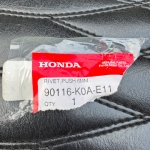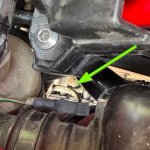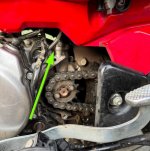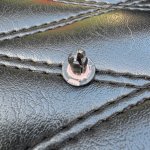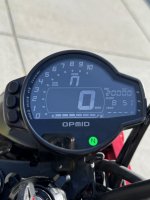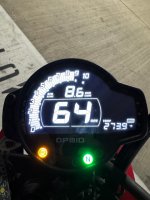BoonDonkey
Member
This is from post #68. I want to thank @Sneaky Dingo for the information and inspiration. I have been complaining about what I thought was non-existent fork rebound damping, e.g. a noticeable clunk on fork rebound when going over bumps. I also had the condition of the front end flopping over when putting the bike on the center stand. I previously tightened then steering stem top nut (the chrome piece) but that had no effect. At the time I didn't have the gumption to dismantle the triple tree assembly. Now I've done the job properly. It's not difficult but my application was complicated slightly be the installed Honda front rack, which attaches to the triple tree. That had to be removed in order to remove the triple tree. I have a collet wrench that fits the steering head bearing lock nut which made the adjusting easy. The nut was loose enough that I could tighten it half a turn with just the stubby wrench. The wrench accepts a 3/8 ratchet handle for applying more torque. I torqued it until the front end turned easily without flopping. This adjustment has reduced both the flop and the "rebound clunking". Both actions are now within acceptable range.Odometer: 10,100 mi
Maintenance updates:
Steering Head Bearings (I dunno what they're called) brought back within spec
I suspected my bearings were not under the right tension, because if it were a bicycle I'd feel the same sensations. Gonna copy-pasta this from the other thread because lazy.
My point for following up on this was that last night, the 29mm socket arrived from Amazon.
Officially what you're supposed to do is take that tool @dmonkey linked to, remove the upper triple clamp, torque it to 22 Nm and then put everything back together again. Unofficially I took my hook wrench, lifted the clamp up 3/4 of the depth of the clamp, and very carefully tightened the steering stem headrace nut. I tightened it to what I thought was roughly the correct spec and checked for handlebar flop to either side.
- 6mm Hex key to undo the 4 bolts on the handlebar mount, torque spec 27 Nm (3-24 service manual, note tightening order), and the upper pinch bolts on the forks, torque spec 29 Nm. (3-22)
- 17mm socket to undo the fork caps, torque spec 22 Nm. (3-23)
- 29mm socket to undo the steering stem nut on the top, torque spec 88 Nm. (3-25)
- Ref: Steering Head Top Nut torque spec is to be initially tightened to 27 Nm. (3-25)
My expectation was that the bearings should bind very, very slightly such that the wheel will not flop over immediately if you lift the front wheel off the ground by pressing the rear wheel down to the ground (sit on the rack), tilt the front wheel slightly to the side, and then bang the seat hard with your fist. This isn't a very scientific test but it's generally indicative of whether the bearings have been overtightened if you're used to what in spec looks like. Like a couple of good whacks, sure, but that first one shouldn't be enough, it should move slightly but not flop completely over to me. Before I started, having it slightly off to the side and doing the ol' seat whack while the wheel was in the air was enough to make it flop. I tightened it until I got to the point where I think it's within spec and called it good.
This morning I rode to work, trying to hit all the undulations that would normally unload the front to generate that wobble I was familiar with. No wobble. Then I hit a couple of manhole covers that were generating a clunk before. No clunk. Looks like the problem for me at least was the tolerance was out of spec.
Thanks again,
BoonDonkey

